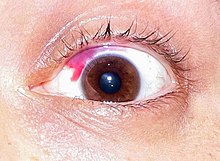| Revision as of 15:14, 16 January 2007 editArcadian (talk | contribs)163,050 edits clean up -- adding nav template using AWB← Previous edit | Revision as of 02:21, 17 January 2007 edit undoArcadian (talk | contribs)163,050 edits link icd10Next edit → | ||
| Line 1: | Line 1: | ||
| {{DiseaseDisorder infobox | | {{DiseaseDisorder infobox | | ||
| Name = Subconjunctival hemorrhage | | Name = Subconjunctival hemorrhage | | ||
| ICD10 = |
ICD10 = {{ICD10|H|11|3|h|10}} | | ||
| ICD9 = {{ICD9|372.72}} | | ICD9 = {{ICD9|372.72}} | | ||
| }} | }} | ||
Revision as of 02:21, 17 January 2007
Medical condition| Subconjunctival bleeding | |
|---|---|
| Specialty | Ophthalmology |

A subconjunctival hemorrhage (or subconjunctival haemmorrhage) is bleeding underneath the conjunctiva. The conjunctiva contains many small, fragile blood vessels that are easily ruptured or broken. When this happens, blood is leaked into the space between the conjunctiva and sclera.
Whereas a bruise typically appears black or blue underneath the skin, a subconjunctival hemorrhage initially appears bright red underneath the transparent conjunctiva. Later the hemorrhage may spread and become green or yellow, like a bruise. Usually this disappears within 2 weeks.
Although its appearance may be alarming, a subconjunctival hemorrhage is generally a painless and harmless condition; however, it may be associated with high blood pressure, or trauma to the eye.
Causes
- Minor eye trauma
- Spontaneously with increased venous pressure
- Coughing
- Touching/widening eyes
- Sneezing
- Vomiting, particularly forced vomiting as seen in bulimia nervosa
- Straining
- Severe alcohol intoxication, leading to raised blood pressure
- Blood dyscrasia (rare)
- Severe hypertension
- LASIK
- Blood thinners, such as ginger, capsaicin, ginseng, garlic, aspirin, or ginkgo if taken in high doses or combined. These can also make the vessels in the eye more susceptible to the pressure causes listed above.
Subconjunctival hemorrhages in infants may be associated with scurvy (a vitamin C deficiency),, abuse or traumatic asphyxia syndrome .
Treatment and management
A subconjunctival hemorrhage is typically a self-limiting condition that requires no treatment in the absence of infection or significant trauma. The elective use of aspirin and NSAIDs is typically discouraged.